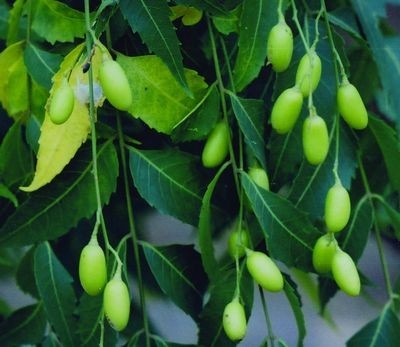
Common Name: Neem, Nimba
English Name: Margosa Tree, Indian Lilac
Botanical Name: Azadirachta indica
Family: Meliaceae
Description: A neem tree can reach a height of about 15 to 20 meters (115-131 ft). The trunk is short, straight and has a diameter of 1.2 m (about 4 ft), wherein the branches spread out widely. Young leaves are reddish to purple in color and turn into dark green pinnate leaves on maturity. The white and fragrant flowers are arranged auxiliary in drooping panicles, about 25 cm in length. The smooth olive-like drupe fruit is elongated-oval to nearly roundish in shape. Fruits are green, turning yellow on ripening, aromatic with garlic like odour. Fresh leaves and flowers come in March-April. Fruits mature between April and August depending upon locality. A native to east India and Burma, it grows in much of south East Asia and West Africa, and more recently Caribbean and south and Central America. In India it occurs naturally in Siwalik Hills, dry forests of Andhra Pradesh, Tamil Nadu and Karnataka to an altitude of approximately 700 m. It is cultivated and frequently naturalized throughout the drier regions of tropical and subtropical India, Pakistan, Sri Lanka, Thailand and Indonesia. It is also grown and often naturalized in Peninsular Malaysia, Singapore, Philippines, Australia, Saudi Arabia, Tropical Africa, the Caribbean, Central and South America5
Chemical Constituent: The chemical constituents contain many biologically active compounds that can be extracted from neem, including alkaloids, lavonoids, triterpenoids, phenolic compounds, carotenoids, steroids and ketones, biologically most active compound is azadirachtin, it is actually a mixture of seven isomeric compounds labelled as azadirachtin A-G and azadirachtin E is more effective. Biologically active principles isolated from different parts of the plant include: Azadirachtin, meliacin, gedunin, nimbidin, nimbolides, salanin, nimbin, valassin, meliacin forms the bitter principles of Neem oil, the seed also contain tignic acid responsible for the distinctive odour of the oil.
Properties: Particularly useful for skin fungi. Neem is effective as Anti-bacterial, including against Staphylococcus & Salmonella. Neem has Anti-viral activity. Small pox and chicken pox are treated with a paste of neem leaves - usually rubbed directly on to the infected skin. Neem has Anti-inflammatory activity. Neem oil and leaf extracts may be the wonder cure for psoriasis. It relieves the itching and pain while reducing the scale and redness of the patchy lesions. In India, millions of people use twigs to clean their teeth and gums every day. Neem is effective in preventing periodontal disease. Neem is used in cosmetics, soap, shampoo, balms, skin creams and oral health products. Neem is used for beautiful skin, and to maintain skin elasticity. Extract of neem leaves is used as a malaria prophylaxis. The compounds nimbidin and nimbin have some spermicidal activity.
Used in the following MATXIN products: